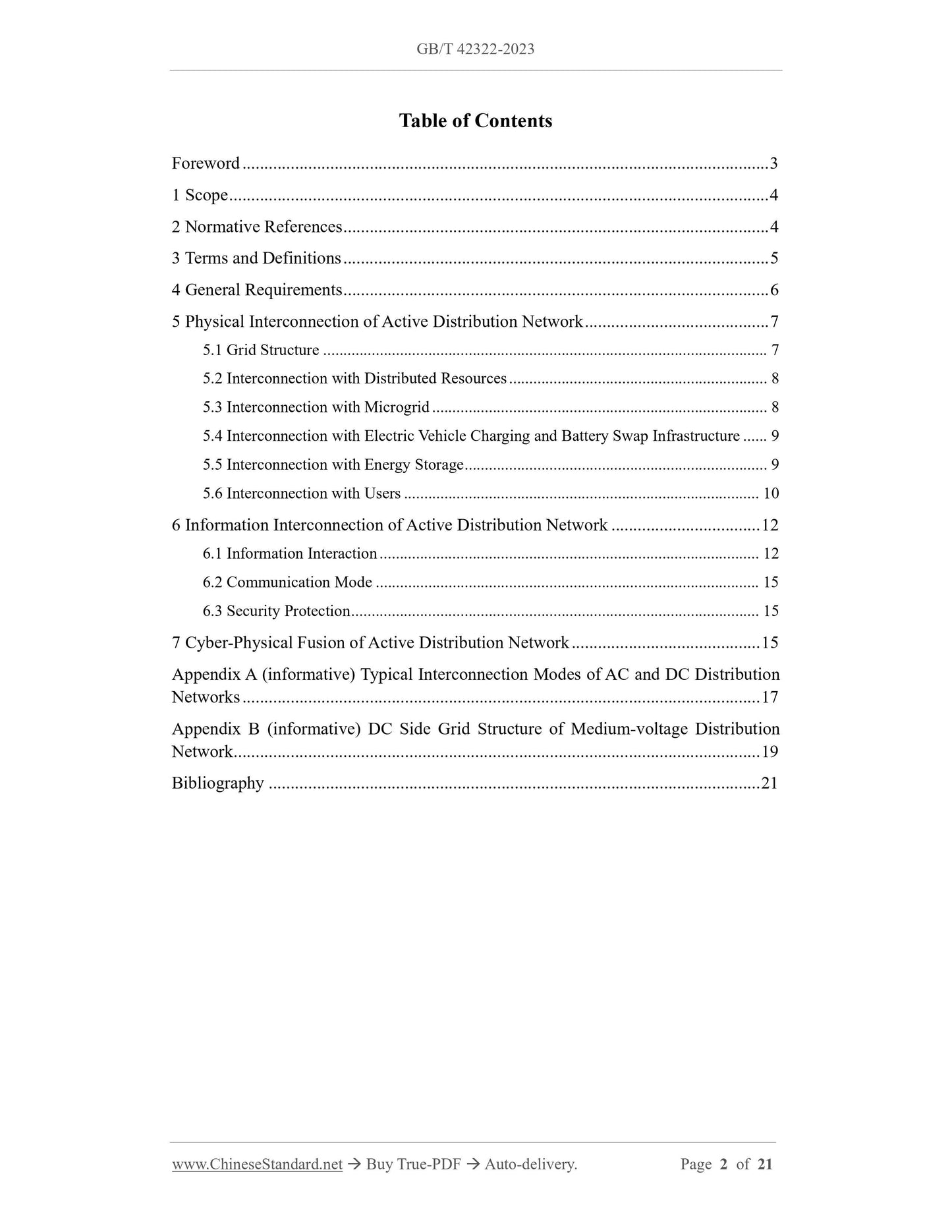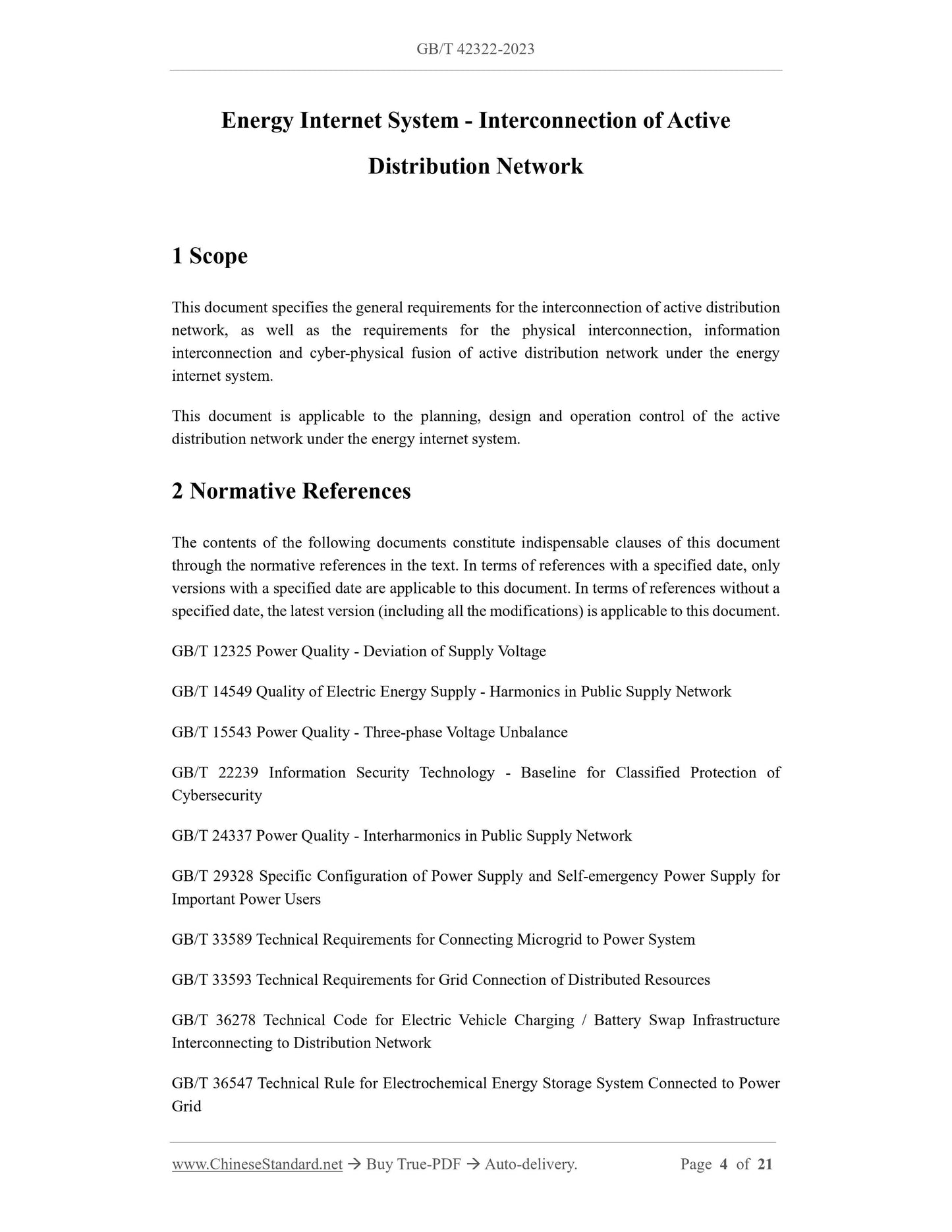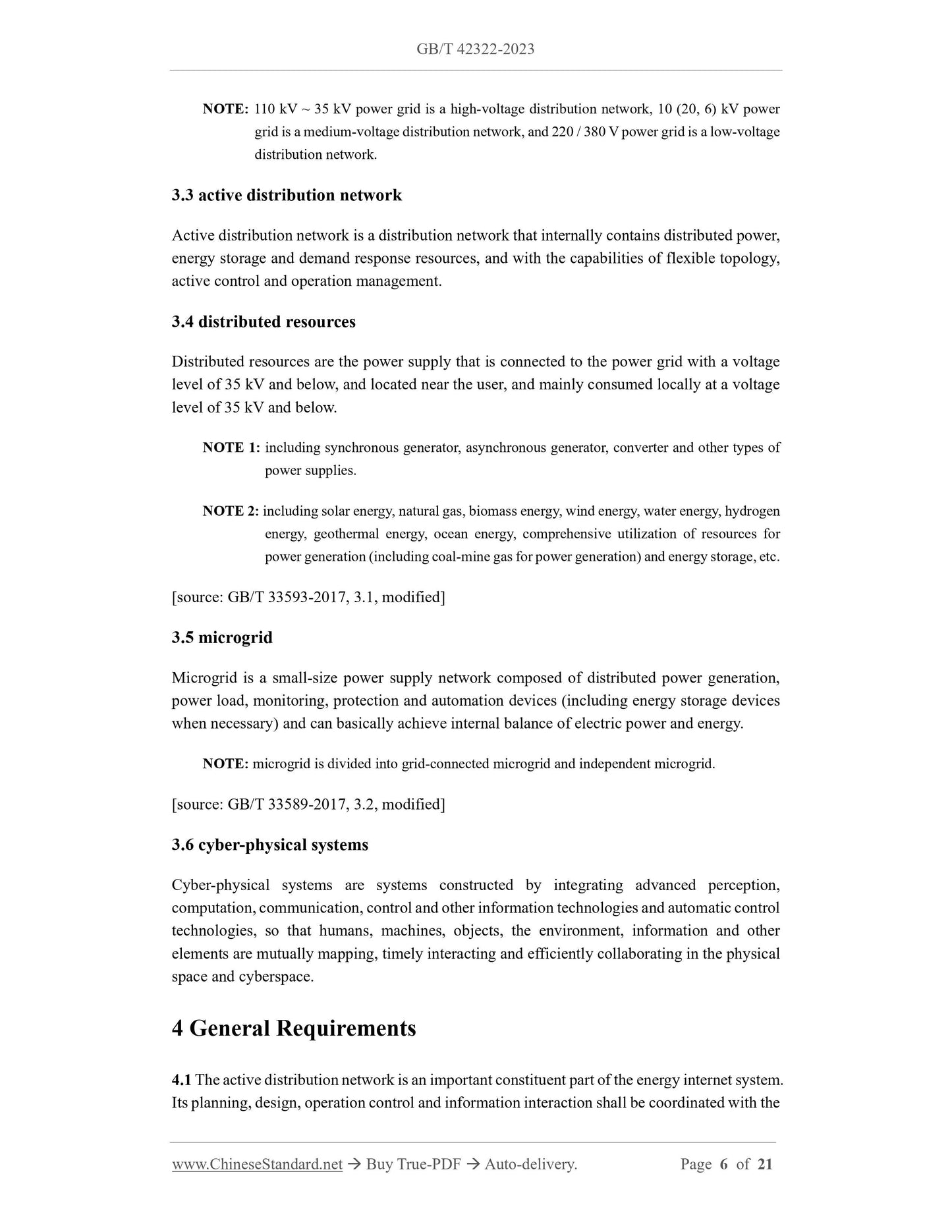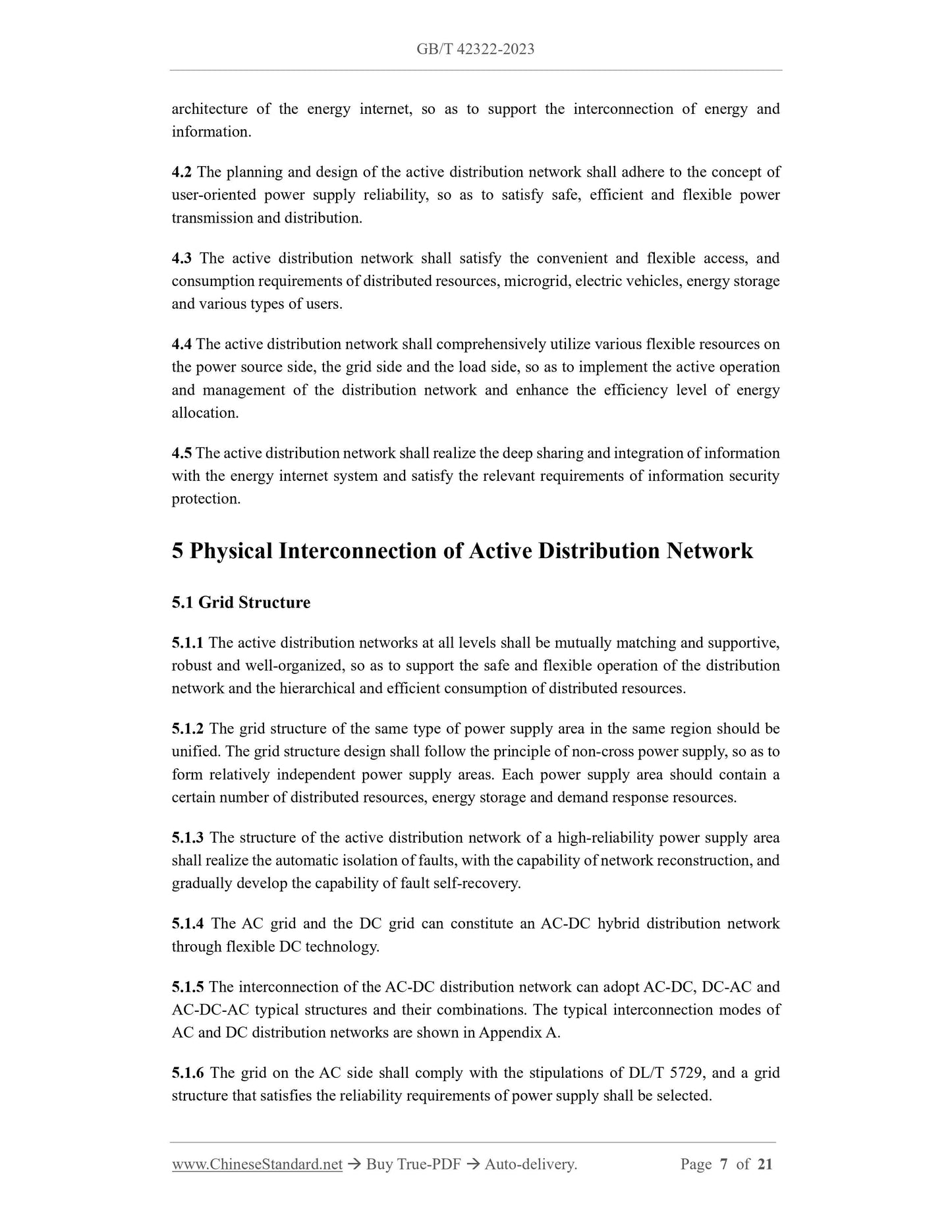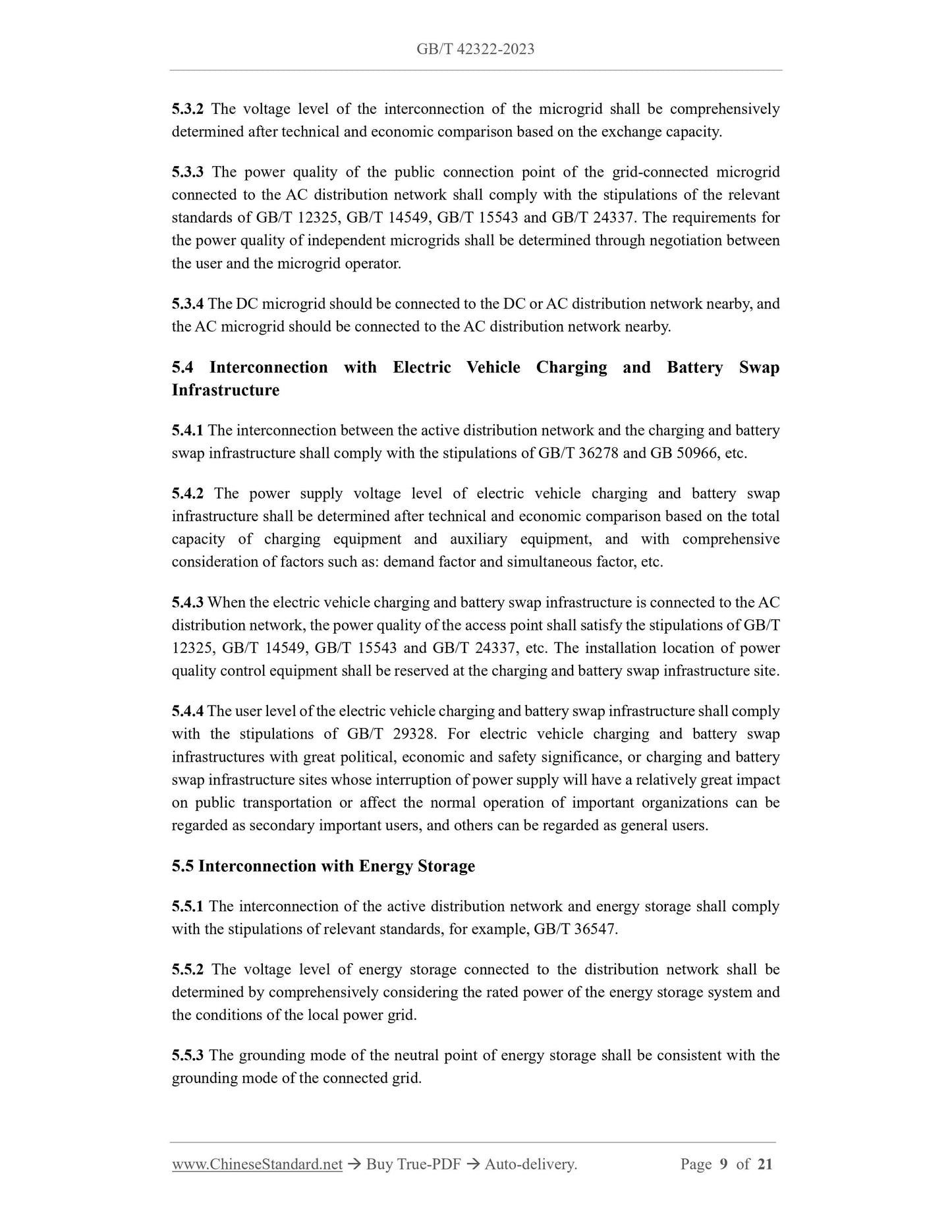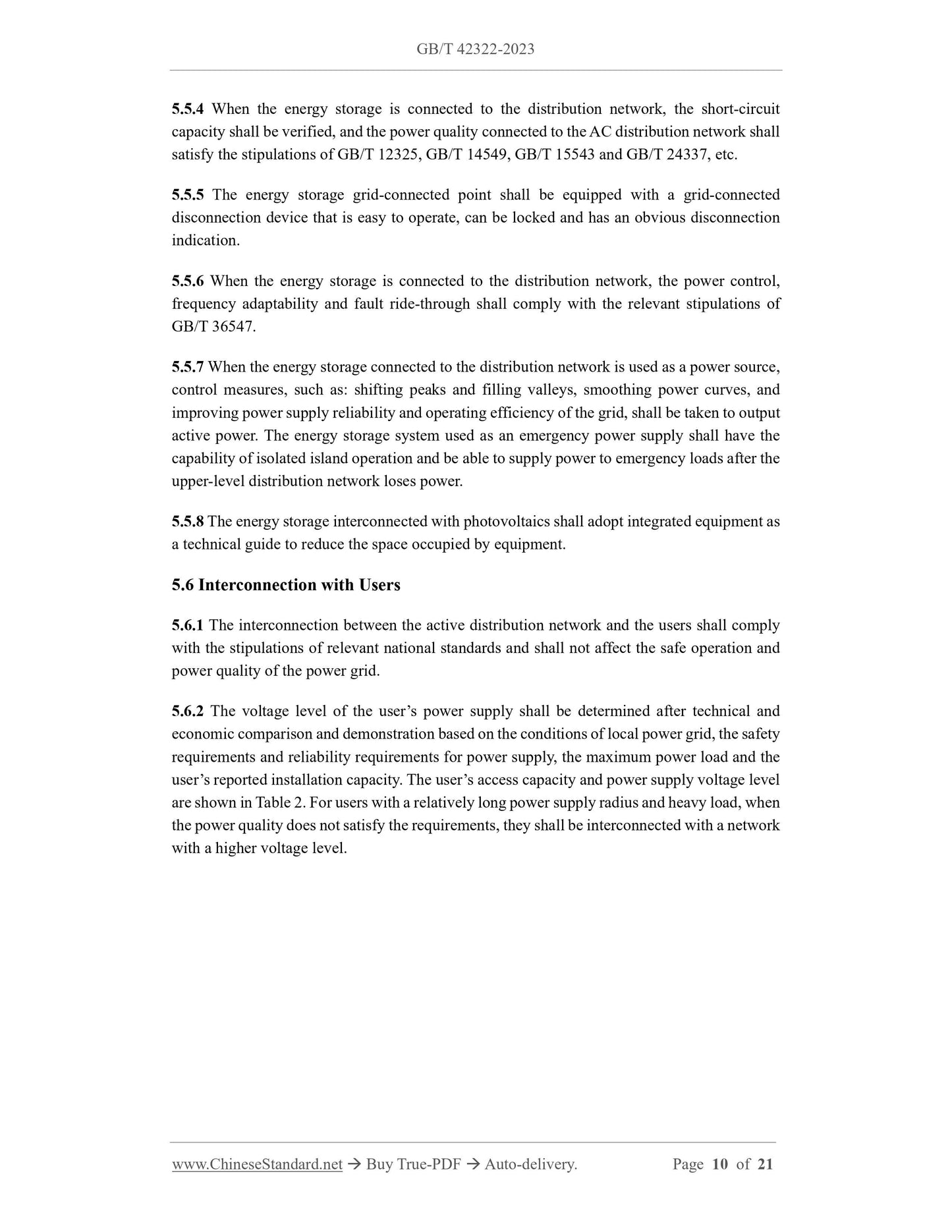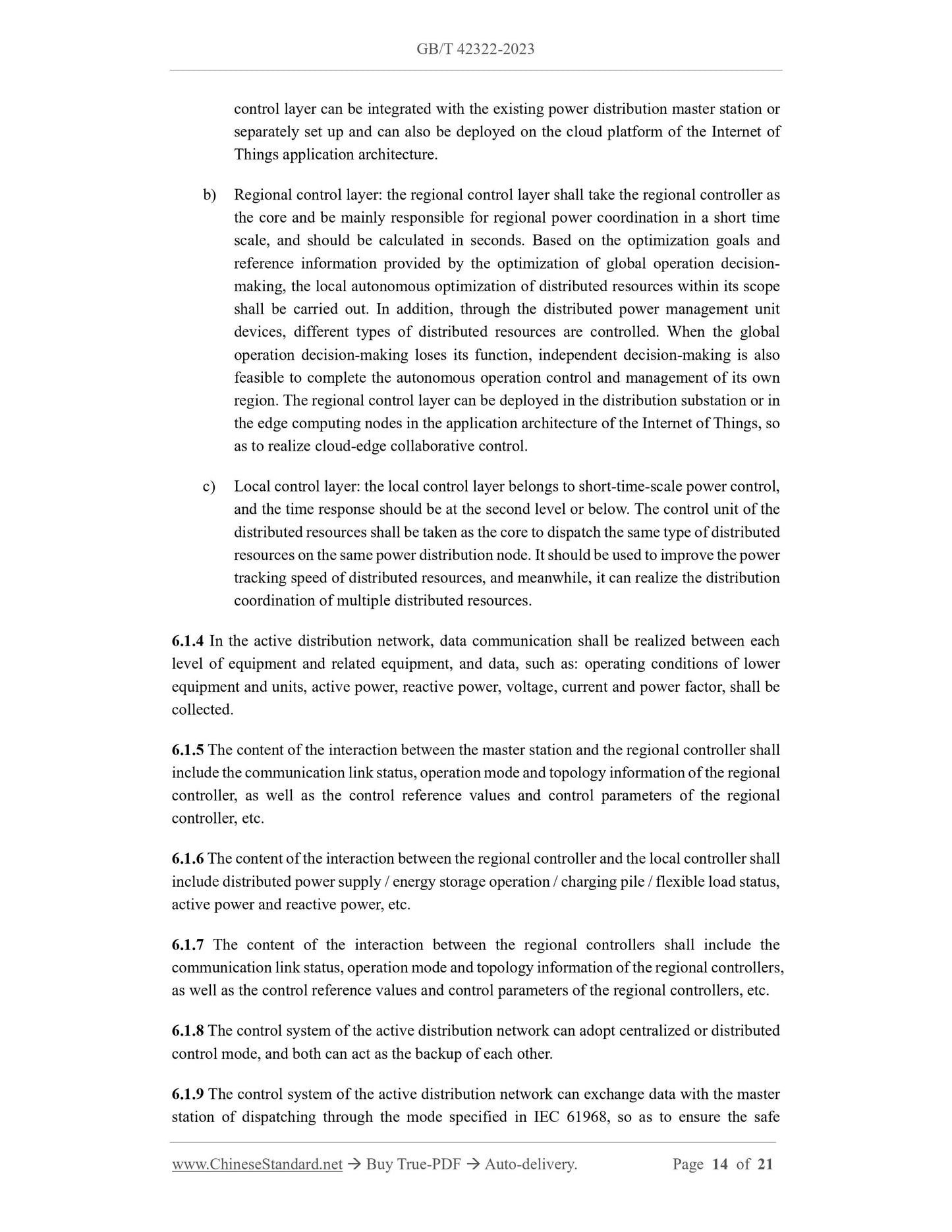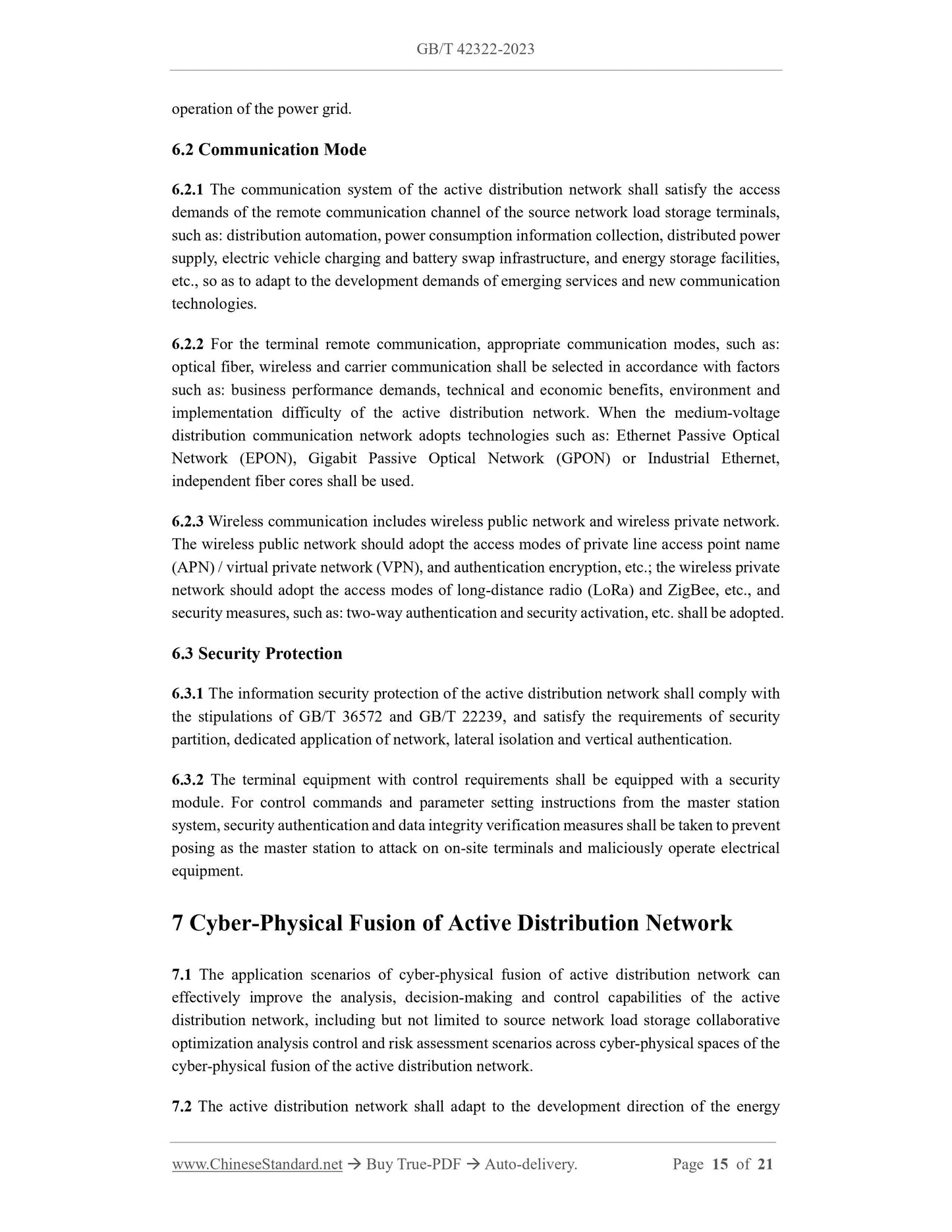NaN
/
of
-Infinity
www.ChineseStandard.us -- Field Test Asia Pte. Ltd.
GB/T 42322-2023 English PDF (GB/T42322-2023)
GB/T 42322-2023 English PDF (GB/T42322-2023)
Regular price
$275.00
Regular price
Sale price
$275.00
Unit price
/
per
Shipping calculated at checkout.
Couldn't load pickup availability
GB/T 42322-2023: Energy internet system - Interconnection of active distribution network
Delivery: 9 seconds. Download (& Email) true-PDF + Invoice.
Get Quotation: Click GB/T 42322-2023 (Self-service in 1-minute)
Historical versions (Master-website): GB/T 42322-2023
Preview True-PDF (Reload/Scroll-down if blank)
GB/T 42322-2023
GB
NATIONAL STANDARD OF THE
PEOPLE’S REPUBLIC OF CHINA
ICS 29.240.01
CCS F 10
Energy Internet System - Interconnection of Active
Distribution Network
ISSUED ON: MARCH 17, 2023
IMPLEMENTED ON: OCTOBER 1, 2023
Issued by: State Administration for Market Regulation;
Standardization Administration of the People’s Republic of China.
Table of Contents
Foreword ... 3
1 Scope ... 4
2 Normative References ... 4
3 Terms and Definitions ... 5
4 General Requirements ... 6
5 Physical Interconnection of Active Distribution Network ... 7
5.1 Grid Structure ... 7
5.2 Interconnection with Distributed Resources ... 8
5.3 Interconnection with Microgrid ... 8
5.4 Interconnection with Electric Vehicle Charging and Battery Swap Infrastructure ... 9
5.5 Interconnection with Energy Storage ... 9
5.6 Interconnection with Users ... 10
6 Information Interconnection of Active Distribution Network ... 12
6.1 Information Interaction ... 12
6.2 Communication Mode ... 15
6.3 Security Protection ... 15
7 Cyber-Physical Fusion of Active Distribution Network ... 15
Appendix A (informative) Typical Interconnection Modes of AC and DC Distribution
Networks ... 17
Appendix B (informative) DC Side Grid Structure of Medium-voltage Distribution
Network ... 19
Bibliography ... 21
Energy Internet System - Interconnection of Active
Distribution Network
1 Scope
This document specifies the general requirements for the interconnection of active distribution
network, as well as the requirements for the physical interconnection, information
interconnection and cyber-physical fusion of active distribution network under the energy
internet system.
This document is applicable to the planning, design and operation control of the active
distribution network under the energy internet system.
2 Normative References
The contents of the following documents constitute indispensable clauses of this document
through the normative references in the text. In terms of references with a specified date, only
versions with a specified date are applicable to this document. In terms of references without a
specified date, the latest version (including all the modifications) is applicable to this document.
GB/T 12325 Power Quality - Deviation of Supply Voltage
GB/T 14549 Quality of Electric Energy Supply - Harmonics in Public Supply Network
GB/T 15543 Power Quality - Three-phase Voltage Unbalance
GB/T 22239 Information Security Technology - Baseline for Classified Protection of
Cybersecurity
GB/T 24337 Power Quality - Interharmonics in Public Supply Network
GB/T 29328 Specific Configuration of Power Supply and Self-emergency Power Supply for
Important Power Users
GB/T 33589 Technical Requirements for Connecting Microgrid to Power System
GB/T 33593 Technical Requirements for Grid Connection of Distributed Resources
GB/T 36278 Technical Code for Electric Vehicle Charging / Battery Swap Infrastructure
Interconnecting to Distribution Network
GB/T 36547 Technical Rule for Electrochemical Energy Storage System Connected to Power
Grid
NOTE: 110 kV ~ 35 kV power grid is a high-voltage distribution network, 10 (20, 6) kV power
grid is a medium-voltage distribution network, and 220 / 380 V power grid is a low-voltage
distribution network.
3.3 active distribution network
Active distribution network is a distribution network that internally contains distributed power,
energy storage and demand response resources, and with the capabilities of flexible topology,
active control and operation management.
3.4 distributed resources
Distributed resources are the power supply that is connected to the power grid with a voltage
level of 35 kV and below, and located near the user, and mainly consumed locally at a voltage
level of 35 kV and below.
NOTE 1: including synchronous generator, asynchronous generator, converter and other types of
power supplies.
NOTE 2: including solar energy, natural gas, biomass energy, wind energy, water energy, hydrogen
energy, geothermal energy, ocean energy, comprehensive utilization of resources for
power generation (including coal-mine gas for power generation) and energy storage, etc.
[source: GB/T 33593-2017, 3.1, modified]
3.5 microgrid
Microgrid is a small-size power supply network composed of distributed power generation,
power load, monitoring, protection and automation devices (including energy storage devices
when necessary) and can basically achieve internal balance of electric power and energy.
NOTE: microgrid is divided into grid-connected microgrid and independent microgrid.
[source: GB/T 33589-2017, 3.2, modified]
3.6 cyber-physical systems
Cyber-physical systems are systems constructed by integrating advanced perception,
computation, communication, control and other information technologies and automatic control
technologies, so that humans, machines, objects, the environment, information and other
elements are mutually mapping, timely interacting and efficiently collaborating in the physical
space and cyberspace.
4 General Requirements
4.1 The active distribution network is an important constituent part of the energy internet system.
Its planning, design, operation control and information interaction shall be coordinated with the
architecture of the energy internet, so as to support the interconnection of energy and
information.
4.2 The planning and design of the active distribution network shall adhere to the concept of
user-oriented power supply reliability, so as to satisfy safe, efficient and flexible power
transmission and distribution.
4.3 The active distribution network shall satisfy the convenient and flexible access, and
consumption requirements of distributed resources, microgrid, electric vehicles, energy storage
and various types of users.
4.4 The active distribution network shall comprehensively utilize various flexible resources on
the power source side, the grid side and the load side, so as to implement the active operation
and management of the distribution network and enhance the efficiency level of energy
allocation.
4.5 The active distribution network shall realize the deep sharing and integration of information
with the energy internet system and satisfy the relevant requirements of information security
protection.
5 Physical Interconnection of Active Distribution Network
5.1 Grid Structure
5.1.1 The active distribution networks at all levels shall be mutually matching and supportive,
robust and well-organized, so as to support the safe and flexible operation of the distribution
network and the hierarchical and efficient consumption of distributed resources.
5.1.2 The grid structure of the same type of power supply area in the same region should be
unified. The grid structure design shall follow the principle of non-cross power supply, so as to
form relatively independent power supply areas. Each power supply area should contain a
certain number of distributed resources, energy storage and demand response resources.
5.1.3 The structure of the active distribution network of a high-reliability power supply area
shall realize the automatic isolation of faults, with the capability of network reconstruction, and
gradually develop the capability of fault self-recovery.
5.1.4 The AC grid and the DC grid can constitute an AC-DC hybrid distribution network
through flexible DC technology.
5.1.5 The interconnection of the AC-DC distribution network can adopt AC-DC, DC-AC and
AC-DC-AC typical structures and their combinations. The typical interconnection modes of
AC and DC distribution networks are shown in Appendix A.
5.1.6 The grid on the AC side shall comply with the stipulations of DL/T 5729, and a grid
structure that satisfies the reliability requirements of power supply shall be selected.
5.3.2 The voltage level of the interconnection of the microgrid shall be comprehensively
determined after technical and economic comparison based on the exchange capacity.
5.3.3 The power quality of the public connection point of the grid-connected microgrid
connected to the AC distribution network shall comply with the stipulations of the relevant
standards of GB/T 12325, GB/T 14549, GB/T 15543 and GB/T 24337. The requirements for
the power quality of independent microgrids shall be determined through negotiation between
the user and the microgrid operator.
5.3.4 The DC microgrid should be connected to the DC or AC distribution network nearby, and
the AC microgrid should be connected to the AC distribution network nearby.
5.4 Interconnection with Electric Vehicle Charging and Battery Swap
Infrastructure
5.4.1 The interconnection between the active distribution network and the charging and battery
swap infrastructure shall comply with the stipulations of GB/T 36278 and GB 50966, etc.
5.4.2 The power supply voltage level of electric vehicle charging and battery swap
infrastructure shall be determined after technical and economic comparison based on the total
capacity of charging equipment and auxiliary equipment, and with comprehensive
consideration of factors such as: demand factor and simultaneous factor, etc.
5.4.3 When the electric vehicle charging and battery swap infrastructure is connected to the AC
distribution network, the power quality of the access point shall satisfy the stipulations of GB/T
12325, GB/T 14549, GB/T 15543 and GB/T 24337, etc. The installation location of power
quality control equipment shall be reserved at the charging and battery swap infrastructure site.
5.4.4 The user level of the electric vehicle charging and battery swap infrastructure shall comply
with the stipulations of GB/T 29328. For electric vehicle charging and battery swap
infrastructures with great political, economic and safety significance, or charging and battery
swap infrastructure sites whose interruption of power supply will have a relatively great impact
on public transportation or affect the normal operation of important organizations can be
regarded as secondary important users, and others can be regarded as general users.
5.5 Interconnection with Energy Storage
5.5.1 The interconnection of the active distribution network and energy storage shall comply
with the stipulations of relevant standards, for example, GB/T 36547.
5.5.2 The voltage level of energy storage connected to the distribution network shall be
determined by comprehensively considering the rated power of the energy storage system and
the conditions of the local power grid.
5.5.3 The grounding mode of the neutral point of energy storage shall be consistent with the
grounding mode of the connected grid.
5.5.4 When the energy storage is connected to the distribution network, the short-circuit
capacity shall be verified, and the power quality connected to the AC distribution network shall
satisfy the stipulations of GB/T 12325, GB/T 14549, GB/T 15543 and GB/T 24337, etc.
5.5.5 The energy storage grid-connected point shall be equipped with a grid-connected
disconnection device that is easy to operate, can be locked and has an obvious disconnection
indication.
5.5.6 When the energy storage is connected to the distribution network, the power control,
frequency adaptability and fault ride-through shall comply with the relevant stipulations of
GB/T 36547.
5.5.7 When the energy storage connected to the distribution network is used as a power source,
control measures, such as: shifting peaks and filling valleys, smoothing power curves, and
improving power supply reliability and operating efficiency of the grid, shall be taken to output
active power. The energy storage system used as an emergency power supply shall have the
capability of isolated island operation and be able to supply power to emergency loads after the
upper-level distribution network loses power.
5.5.8 The energy storage interconnected with photovoltaics shall adopt integrated equipment as
a technical guide to reduce the space occupied by equipment.
5.6 Interconnection with Users
5.6.1 The interconnection between the active distribution network and the users shall comply
with the stipulations of relevant national standards and shall not affect the safe operation and
power quality of the power grid.
5.6.2 The voltage level of the user’s power supply shall be determined after technical and
economic comparison and demonstration based on the conditions of local power grid, the safety
requirements and reliability requirements for power supply, the maximum power load and the
user’s reported installation capacity. The user’s access capacity and power supply voltage level
are shown in Table 2. For users with a relatively long power supply radius and heavy load, when
the power quality does not satisfy the requirements, they shall be interconnected with a network
with a higher voltage level.
control layer can be integrated with the existing power distribution master station or
separately set up and can also be deployed on the cloud platform of the Internet of
Things application architecture.
b) Regional control layer: the regional control layer shall take the regional controller as
the core and be mainly responsible for regional power coordination in a short time
scale, and should be calculated in seconds. Based on the optimization goals and
reference information provided by the optimization of global operation decision-
making, the local autonomous optimization of distributed resources within its scope
shall be carried out. In addition, through the distributed power management unit
devices, different types of distributed resources are controlled. When the global
operation decision-making loses its function, independent decision-making is also
feasible to complete the autonomous operation control and management of its own
region. The regional control layer can be deployed in the distribution substation or in
the edge computing nodes in the application architecture of the Internet of Things, so
as to realize cloud-edge collaborative control.
c) Local control layer: the local control layer belongs to short-time-scale p...
Delivery: 9 seconds. Download (& Email) true-PDF + Invoice.
Get Quotation: Click GB/T 42322-2023 (Self-service in 1-minute)
Historical versions (Master-website): GB/T 42322-2023
Preview True-PDF (Reload/Scroll-down if blank)
GB/T 42322-2023
GB
NATIONAL STANDARD OF THE
PEOPLE’S REPUBLIC OF CHINA
ICS 29.240.01
CCS F 10
Energy Internet System - Interconnection of Active
Distribution Network
ISSUED ON: MARCH 17, 2023
IMPLEMENTED ON: OCTOBER 1, 2023
Issued by: State Administration for Market Regulation;
Standardization Administration of the People’s Republic of China.
Table of Contents
Foreword ... 3
1 Scope ... 4
2 Normative References ... 4
3 Terms and Definitions ... 5
4 General Requirements ... 6
5 Physical Interconnection of Active Distribution Network ... 7
5.1 Grid Structure ... 7
5.2 Interconnection with Distributed Resources ... 8
5.3 Interconnection with Microgrid ... 8
5.4 Interconnection with Electric Vehicle Charging and Battery Swap Infrastructure ... 9
5.5 Interconnection with Energy Storage ... 9
5.6 Interconnection with Users ... 10
6 Information Interconnection of Active Distribution Network ... 12
6.1 Information Interaction ... 12
6.2 Communication Mode ... 15
6.3 Security Protection ... 15
7 Cyber-Physical Fusion of Active Distribution Network ... 15
Appendix A (informative) Typical Interconnection Modes of AC and DC Distribution
Networks ... 17
Appendix B (informative) DC Side Grid Structure of Medium-voltage Distribution
Network ... 19
Bibliography ... 21
Energy Internet System - Interconnection of Active
Distribution Network
1 Scope
This document specifies the general requirements for the interconnection of active distribution
network, as well as the requirements for the physical interconnection, information
interconnection and cyber-physical fusion of active distribution network under the energy
internet system.
This document is applicable to the planning, design and operation control of the active
distribution network under the energy internet system.
2 Normative References
The contents of the following documents constitute indispensable clauses of this document
through the normative references in the text. In terms of references with a specified date, only
versions with a specified date are applicable to this document. In terms of references without a
specified date, the latest version (including all the modifications) is applicable to this document.
GB/T 12325 Power Quality - Deviation of Supply Voltage
GB/T 14549 Quality of Electric Energy Supply - Harmonics in Public Supply Network
GB/T 15543 Power Quality - Three-phase Voltage Unbalance
GB/T 22239 Information Security Technology - Baseline for Classified Protection of
Cybersecurity
GB/T 24337 Power Quality - Interharmonics in Public Supply Network
GB/T 29328 Specific Configuration of Power Supply and Self-emergency Power Supply for
Important Power Users
GB/T 33589 Technical Requirements for Connecting Microgrid to Power System
GB/T 33593 Technical Requirements for Grid Connection of Distributed Resources
GB/T 36278 Technical Code for Electric Vehicle Charging / Battery Swap Infrastructure
Interconnecting to Distribution Network
GB/T 36547 Technical Rule for Electrochemical Energy Storage System Connected to Power
Grid
NOTE: 110 kV ~ 35 kV power grid is a high-voltage distribution network, 10 (20, 6) kV power
grid is a medium-voltage distribution network, and 220 / 380 V power grid is a low-voltage
distribution network.
3.3 active distribution network
Active distribution network is a distribution network that internally contains distributed power,
energy storage and demand response resources, and with the capabilities of flexible topology,
active control and operation management.
3.4 distributed resources
Distributed resources are the power supply that is connected to the power grid with a voltage
level of 35 kV and below, and located near the user, and mainly consumed locally at a voltage
level of 35 kV and below.
NOTE 1: including synchronous generator, asynchronous generator, converter and other types of
power supplies.
NOTE 2: including solar energy, natural gas, biomass energy, wind energy, water energy, hydrogen
energy, geothermal energy, ocean energy, comprehensive utilization of resources for
power generation (including coal-mine gas for power generation) and energy storage, etc.
[source: GB/T 33593-2017, 3.1, modified]
3.5 microgrid
Microgrid is a small-size power supply network composed of distributed power generation,
power load, monitoring, protection and automation devices (including energy storage devices
when necessary) and can basically achieve internal balance of electric power and energy.
NOTE: microgrid is divided into grid-connected microgrid and independent microgrid.
[source: GB/T 33589-2017, 3.2, modified]
3.6 cyber-physical systems
Cyber-physical systems are systems constructed by integrating advanced perception,
computation, communication, control and other information technologies and automatic control
technologies, so that humans, machines, objects, the environment, information and other
elements are mutually mapping, timely interacting and efficiently collaborating in the physical
space and cyberspace.
4 General Requirements
4.1 The active distribution network is an important constituent part of the energy internet system.
Its planning, design, operation control and information interaction shall be coordinated with the
architecture of the energy internet, so as to support the interconnection of energy and
information.
4.2 The planning and design of the active distribution network shall adhere to the concept of
user-oriented power supply reliability, so as to satisfy safe, efficient and flexible power
transmission and distribution.
4.3 The active distribution network shall satisfy the convenient and flexible access, and
consumption requirements of distributed resources, microgrid, electric vehicles, energy storage
and various types of users.
4.4 The active distribution network shall comprehensively utilize various flexible resources on
the power source side, the grid side and the load side, so as to implement the active operation
and management of the distribution network and enhance the efficiency level of energy
allocation.
4.5 The active distribution network shall realize the deep sharing and integration of information
with the energy internet system and satisfy the relevant requirements of information security
protection.
5 Physical Interconnection of Active Distribution Network
5.1 Grid Structure
5.1.1 The active distribution networks at all levels shall be mutually matching and supportive,
robust and well-organized, so as to support the safe and flexible operation of the distribution
network and the hierarchical and efficient consumption of distributed resources.
5.1.2 The grid structure of the same type of power supply area in the same region should be
unified. The grid structure design shall follow the principle of non-cross power supply, so as to
form relatively independent power supply areas. Each power supply area should contain a
certain number of distributed resources, energy storage and demand response resources.
5.1.3 The structure of the active distribution network of a high-reliability power supply area
shall realize the automatic isolation of faults, with the capability of network reconstruction, and
gradually develop the capability of fault self-recovery.
5.1.4 The AC grid and the DC grid can constitute an AC-DC hybrid distribution network
through flexible DC technology.
5.1.5 The interconnection of the AC-DC distribution network can adopt AC-DC, DC-AC and
AC-DC-AC typical structures and their combinations. The typical interconnection modes of
AC and DC distribution networks are shown in Appendix A.
5.1.6 The grid on the AC side shall comply with the stipulations of DL/T 5729, and a grid
structure that satisfies the reliability requirements of power supply shall be selected.
5.3.2 The voltage level of the interconnection of the microgrid shall be comprehensively
determined after technical and economic comparison based on the exchange capacity.
5.3.3 The power quality of the public connection point of the grid-connected microgrid
connected to the AC distribution network shall comply with the stipulations of the relevant
standards of GB/T 12325, GB/T 14549, GB/T 15543 and GB/T 24337. The requirements for
the power quality of independent microgrids shall be determined through negotiation between
the user and the microgrid operator.
5.3.4 The DC microgrid should be connected to the DC or AC distribution network nearby, and
the AC microgrid should be connected to the AC distribution network nearby.
5.4 Interconnection with Electric Vehicle Charging and Battery Swap
Infrastructure
5.4.1 The interconnection between the active distribution network and the charging and battery
swap infrastructure shall comply with the stipulations of GB/T 36278 and GB 50966, etc.
5.4.2 The power supply voltage level of electric vehicle charging and battery swap
infrastructure shall be determined after technical and economic comparison based on the total
capacity of charging equipment and auxiliary equipment, and with comprehensive
consideration of factors such as: demand factor and simultaneous factor, etc.
5.4.3 When the electric vehicle charging and battery swap infrastructure is connected to the AC
distribution network, the power quality of the access point shall satisfy the stipulations of GB/T
12325, GB/T 14549, GB/T 15543 and GB/T 24337, etc. The installation location of power
quality control equipment shall be reserved at the charging and battery swap infrastructure site.
5.4.4 The user level of the electric vehicle charging and battery swap infrastructure shall comply
with the stipulations of GB/T 29328. For electric vehicle charging and battery swap
infrastructures with great political, economic and safety significance, or charging and battery
swap infrastructure sites whose interruption of power supply will have a relatively great impact
on public transportation or affect the normal operation of important organizations can be
regarded as secondary important users, and others can be regarded as general users.
5.5 Interconnection with Energy Storage
5.5.1 The interconnection of the active distribution network and energy storage shall comply
with the stipulations of relevant standards, for example, GB/T 36547.
5.5.2 The voltage level of energy storage connected to the distribution network shall be
determined by comprehensively considering the rated power of the energy storage system and
the conditions of the local power grid.
5.5.3 The grounding mode of the neutral point of energy storage shall be consistent with the
grounding mode of the connected grid.
5.5.4 When the energy storage is connected to the distribution network, the short-circuit
capacity shall be verified, and the power quality connected to the AC distribution network shall
satisfy the stipulations of GB/T 12325, GB/T 14549, GB/T 15543 and GB/T 24337, etc.
5.5.5 The energy storage grid-connected point shall be equipped with a grid-connected
disconnection device that is easy to operate, can be locked and has an obvious disconnection
indication.
5.5.6 When the energy storage is connected to the distribution network, the power control,
frequency adaptability and fault ride-through shall comply with the relevant stipulations of
GB/T 36547.
5.5.7 When the energy storage connected to the distribution network is used as a power source,
control measures, such as: shifting peaks and filling valleys, smoothing power curves, and
improving power supply reliability and operating efficiency of the grid, shall be taken to output
active power. The energy storage system used as an emergency power supply shall have the
capability of isolated island operation and be able to supply power to emergency loads after the
upper-level distribution network loses power.
5.5.8 The energy storage interconnected with photovoltaics shall adopt integrated equipment as
a technical guide to reduce the space occupied by equipment.
5.6 Interconnection with Users
5.6.1 The interconnection between the active distribution network and the users shall comply
with the stipulations of relevant national standards and shall not affect the safe operation and
power quality of the power grid.
5.6.2 The voltage level of the user’s power supply shall be determined after technical and
economic comparison and demonstration based on the conditions of local power grid, the safety
requirements and reliability requirements for power supply, the maximum power load and the
user’s reported installation capacity. The user’s access capacity and power supply voltage level
are shown in Table 2. For users with a relatively long power supply radius and heavy load, when
the power quality does not satisfy the requirements, they shall be interconnected with a network
with a higher voltage level.
control layer can be integrated with the existing power distribution master station or
separately set up and can also be deployed on the cloud platform of the Internet of
Things application architecture.
b) Regional control layer: the regional control layer shall take the regional controller as
the core and be mainly responsible for regional power coordination in a short time
scale, and should be calculated in seconds. Based on the optimization goals and
reference information provided by the optimization of global operation decision-
making, the local autonomous optimization of distributed resources within its scope
shall be carried out. In addition, through the distributed power management unit
devices, different types of distributed resources are controlled. When the global
operation decision-making loses its function, independent decision-making is also
feasible to complete the autonomous operation control and management of its own
region. The regional control layer can be deployed in the distribution substation or in
the edge computing nodes in the application architecture of the Internet of Things, so
as to realize cloud-edge collaborative control.
c) Local control layer: the local control layer belongs to short-time-scale p...










